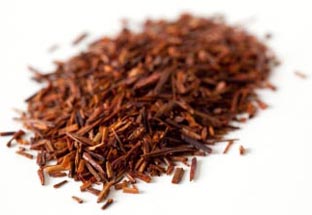
Name: Rooibos (Aspalathus linearis)
Perennial
Family: Fabaceae
Common names: South African red tea, red tea, bush tea, rotbusch
Range: Native to the Western Cape province of South Africa
Parts Used: Leaves
Preparations: Prepared as tea
History: Rooibos is of great economic importance to South Africa, where the plant is widely distributed naturally in the region known as the “red bush belt” of the Western Cape. For the most part, harvesting the plant is done the same way today as it was hundreds of years ago – the above-ground parts are finely cut, watered, piled in mounds and then left to “sweat” to permit oxidation of the phenolic compounds in the leaves. Once the characteristic reddish color is obtained, the material is spread out and left to dry in the sun.
Constituents: Rooibos contains various flavonoid glycosides with antioxidant properties, such as quercetin. The herb is also a rich source of a rare class of antioxidant polyphenols called dihydrochalcones, including nothofagin and aspalathin. Studies show that these phytochemicals produce anti-tumor effects in animals with chemically-induced esophageal tumors. Rooibos compounds also inhibit the enzyme AMP-activated protein kinase, which decreases triglyceride and cholesterol levels in the blood.
Cautions/Contraindications: While there are no significant reports of adverse effects, research is still preliminary. Safety during pregnancy and lactation has not been established. Consult your physician before using this herb if you have a chronic medical condition or take pharmaceutical medications.
Disclaimer: This information has not been evaluated by the U.S. Food and Drug Administration and is not intended to diagnose, treat, cure, or prevent any disease.